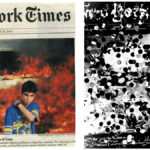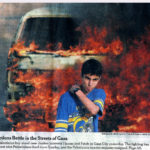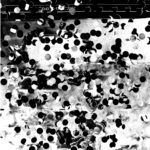The May 15, 2007 clipping from the front page of the New York Times that I used to create this piece includes a photograph taken by Palestinian photographer Mohammed Abed. The caption reads “A Palestinian youth standing near a burning vehicle today during clashes between political rivals Fatah and Hamas in Gaza City”. Abed’s photograph can be described as having three distinct focal points: 1) a blazing car on fire in the background, 2) a Palestinian teenage boy’s intense facial expression, and 3) the boy’s surprisingly clean, sky blue St. Louis Rams American football jersey. The juxtaposition of these three “filters” in the composition is remarkably strange, and constitutes a well composed, incredibly dramatic, mysterious, and effective news-media image. However, there has been much debate recently about the authenticity of many images coming from Arab photographers, which completely erupted after the Adnan Hajj controversy, when one of his photographs for Reuters was admittedly doctored in Photoshop. The photographer Mohammed Abed, who took this photograph, has also been accused, not of doctoring photographs, but of staging them for dramatic effect. Was this image staged? If so, is it possible to justify journalists working under these conditions as operating under different moral pretenses, that they need to construct simplified “fictions” to better explicate what are very true, complex, and tragic realities? The U.S. government, of course, has also been accused of constructing similar fictions (albeit with more expensive production values) like the filmed rescue of Jessica Lynch for example, to create a heroic figure to boost moral among citizens back home. In a digital age where the manipulation or staging of events is always possible, it appears that the images that document history don’t have to be truthful, they just have be believable. Fictional, dramatic devices, borrowed from the entertainment industry, have become part of the visual language of reality”, and thus influence how military conflict is reported, and how history is interpreted. I am interested in slowing down the viewing process of this photograph, to question how these kinds of images construct a collective notion of conflict that in many of our imaginations is as removed and fictional as any image from an American action movie. I photocopied the clipping several times, and then using a scissors and a hole-punch, began layering small sections and fragments into a complex visual field. The collaged result was then photographed and inverted into a negative image.
Contributors: Erika Adams (Boston, MA), Razan Alazzouni (Boston, MA), Chad Arnholt (Boston, MA), Elaine Bay (Boston, MA), Janine Biunno (Boston, MA), Rob Erickson (Brooklyn, NY), Noah Fischer (Brooklyn, NY), Melinda Go (Boston, MA), Rebecca Bird Grigsby (Boston, MA), Harvey Loves Harvey (Boston, MA, Brooklyn, NY), Lisa Hecht (Milwaukee, WI), Alysia Kaplan (Chicago, IL), Louise Krampien (Boston, MA), Norma Lopez (Boston, MA), Jessica Marx (Boston, MA), Stefano Pasquini (Bologna, Italy), Rhonda Ratray (Boston, MA), Vinicius Sanchez (Boston, MA), Jennifer Schmidt (Brooklyn, NY), Jessica Scott-Dutcher (Boston, MA), Victoria Shen (Boston, MA), Kirk Snow (Boston, MA), Marcelino Stuhmer (Milwaukee, WI), Pedro Velez (Puerto Rico) with Gamaliel Rodríguez-Ayala (Oslo, Norway), Gabe Ventura (Boston, MA), Stefanie Vermillion (Boston, MA), W&N (Puerto Rico), Marine Wallon (Paris, France), Terrance Wong (Boston, MA), Tina Ye (Boston, MA), Jennifer Yorke (Chicago, IL).
“Event Horizon seeks to create a site for inquiry into the nature of current events & history through the use of print media, performance, and individual interpretation. Artists within Event Horizon interpret and re-present topics, headlines, graphics, and text found in widely circulated newspapers, broadsides, and fliers to produce creative, critical, and poetic interplays of information. The reader’s ability to translate and creatively respond to “popular” issues will underscore a story or subject’s meaning, thereby exposing “the style” of interpretation as a determinant element of how events or topics are individually understood and communicated to a larger public. You’re welcome to engage notions of the “newsworthy” through absurdist, practical, educational, comic, mundane, and dramatic presentations of topical material.”
Curator, Jennifer Schmidt, School of the Museum of Fine Arts, Boston, MA


